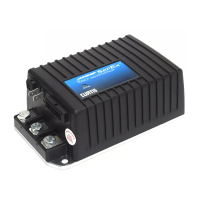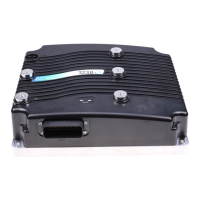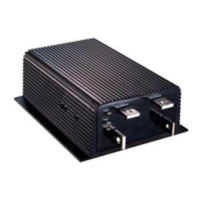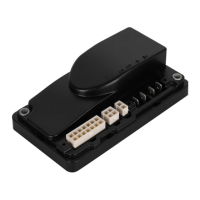22
Curtis 1230 Manual, Rev. C
2 — INSTALLATION & WIRING: Switches, etc.
Electromagnetic Brake
The electromagnetic brake, which is usually mounted to the motor shaft, is
mechanically engaged by a spring force and electrically released. In wiring
configurations A and B, the brake is connected to J2 Pins 3 and 6. The PWM
low-side driver at Pin 6 is rated at 2 amps and is monitored for overcurrent
faults. In wiring configuration C, the brake is connected to the digital on/off
output at J1 Pin 24; in this configuration, there is no brake fault checking.
Valves
The hydraulic line’s load holding valve (if used) and lowering valve or propor-
tional valve (whichever is used) should be large enough to provide adequate
flow when open. The load holding valve’s solenoid coil should be rated at the
nominal battery voltage of the system and must not exceed the 2 amp rating
of its driver. The lowering or proportional valve solenoid coil should be rated
at or below the nominal battery voltage and should be capable of opening the
valve completely using not less than 0.25 amp and not more than 2 amps.
Speed Limit Input
As shown in wiring configurations A and B (pages 8 and 10), a potentiometer
can be used to limit speed; alternatively, a switch can be used, as shown in
configuration C (page 12). The Speed Limit Type parameter configures the speed
limit input. The Min Speed parameter sets the maximum speed at full throttle
when the speed pot wiper is shorted to the Pot Low connection (Pin 7), or the
speed limit switch is in the Min Speed position. The Max Speed parameter
sets the maximum speed at full throttle when the wiper is shorted to Pot High
(Pin 5), or the switch is in the Max Speed position.
Battery LED and Status LED Outputs
The 1230 has two signal outputs (J1 Pins 17 and 18) that can be used to pro-
vide diagnostic battery and controller status information. These outputs provide
low side drivers that pull to B- when active. They are rated at 10 mA and are
designed to light indicator LEDs integrated into a display panel. However, they
can be used to drive any load requiring less than 10 mA of drive current.
Circuitry Protection Devices
To protect the control circuitry from accidental shorts, a low current fuse (ap-
propriate for the maximum current draw) should be connected in series with the
battery feed to the keyswitch. Additionally, a high current fuse should be wired
in series with the main contactor to protect the motor, controller, and batteries
from accidental shorts in the power system; this fuse can be mounted directly
on the controller. The appropriate fuse for each application should be selected
with the help of a reputable fuse manufacturer or dealer. The standard wiring
diagrams (Figures 3–5) show the recommended location for each fuse.
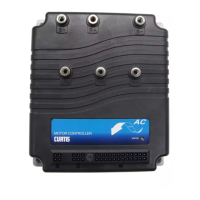
